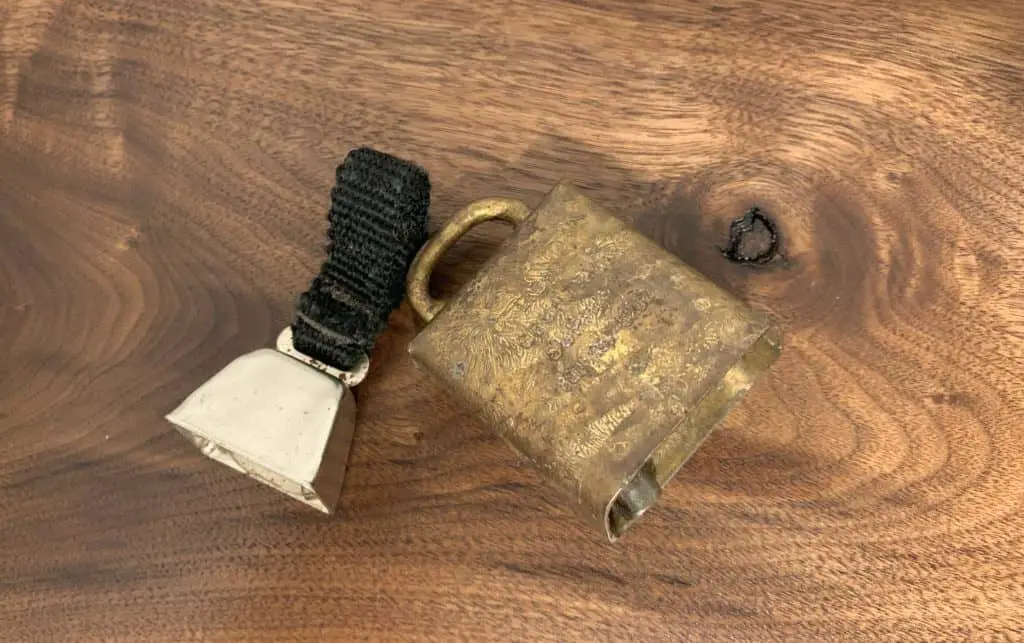
The hunting dog sports are rich in tradition. One of those traditions is to strap old, often handmade, bells on hunting dog’s collars before releasing them to begin a hunt. These bells often have a metallic clack far from the musical tone of other bells. But the place bells hold in the hunting dog world is this more than just a tradition.
Why do hunting dogs wear bells? Hunters often put bells on their dog’s collars in order keep track of their dog’s location especially heavy cover where the dog can’t always be seen. Typically hunting dogs are free to run without leash which allows them to cover a lot of ground in their search. The hunter might lose sight of the dog as it searches but can keep track of the dog’s location by listening for the bell’s jingle as the dog moves. Knowing where the dog is allows for a safer more effective hunt.
There are a number of reasons why the hunter needs to constantly keep track of their dog’s location:
- Safety: listening to the bell and knowing the dog’s location, the hunter has a good idea of what direction it is safe to shoot at game without hitting the dog. Game hunted with dogs is typically hunted with shotguns. A single shotgun shell is comprised of hundreds of small bb’s. When the shotgun is fired all these bb’s exit the gun together and spread into a wide pattern as they get further from the gun. Because of this wide pattern of bb’s, safe shots should only be taken well clear of the dog’s location. Not knowing the dog’s location means the hunter would need to pass (not take) shots at game or risk injuring the dog. An example of this is when hunting rabbits with hounds, hounds are taught to trail running rabbits chasing them in wide circles that allow the hunter to position themselves to get a shot at the rabbit as it runs past. If the hunter does not know where the dog is in relation to the rabbit they run the risk of taking unsafe shots, especially unsafe as the hunter is aiming toward a rabbit running along the ground at the same level as the dog.
- Success: Knowing where the dog is will allow the hunter to be more successful harvesting game. The dog has an important role in the hunting partnership; as the game finder. The advantage of the dog is they can cover much more ground and use their nose to scent and find animals. This means that game is most often found by the dog first, before the hunter and most likely flush (flees from hiding) near to the dog. Knowing where the dog is allows the hunter to more quickly react to game flushed from the dog’s location and place a good shot. An example of this is when hunting grouse with Labradors, where the dogs are often moving through thick cover flushing hidden birds they scent for the hunter to shoot. If the hunter doesn’t know where the dog is, they could likely be looking in the wrong direction when the dog flushes a bird and will not make the shot.
- Obedience: when the dog cannot be seen the bell is an important tool for obedience. It tells the hunter when the dog is ranging too far away and needs to be recalled. It can also indicate to the hunter when a dog is chasing non-target game such as running after a deer when the dog should be bird hunting. A faint bell means the dog is likely too far way and any game that flushes near the dog will be out of range of the hunter. A bell changing patter from a dog moving back and forth in front of the hunter to quickly fading into the distance could indicate a dog chasing a deer.
Types of Hunting Where Dogs Wear Bells
Bells on flushing dogs to hunt upland birds in heavy cover: Flushing dogs refers to subset of hunting dogs that do not pause when they find a game bird, but immediately chases the bird into the air (called flushing the bird) which gives the hunter the opportunity to shoot the bird. Common flushing dog breeds are spaniels and retrievers. When hunting birds with flushing dogs, the bell allows the hunter to keep track of the dog and know likely locations that are safe to take a shot when a bird is flushed by the dog. The bell also lets the hunter know when the flushing dog is ranging too far away from the hunter and needs to be recalled. A far-ranging flushing dog results in the dog flushing the bird out of range of the hunter’s ability to effectively hit and harvest it.
Bells on pointing dogs to hunt upland birds in heavy cover: Pointing dogs refers to a subset of hunting dogs that stand still when they smell game, effectively pointing with their nose to where the game is hidden. The act of the dog standing still when smelling game is called a dog being “on point”. Common pointing breeds include setters and pointers. A bell on a pointing dog works differently than one on a flushing dog. The hunter with a pointing dog must always keep track of the dog because when the dog finds a bird, the dog will stop, and the bell will go silent. So, the hunter is concentrating on and waiting for the absence of the bell’s jingle as that means the dog has found a bird. Once the bell is silent, the hunter must move in the direction the bell was last heard to locate the dog. Game birds instinctively hold their position hoping the danger will past without noticing them. Because of this, the hunter has time to reach dog on point before the bird flies. The hunter then flushes and shoots the bird while the dog holds still (termed holding “steady”).
Bells on Hounds to Hunt Furred Game in Heavy Cover
Hounds refers to a subset of hunting dogs that track and often tree furred game. Common hound breeds are beagles, bloodhounds and blue ticks. Hounds are often released by hunters to cover ground. When they cross the track of a target animal they will turn to follow the sent trail of the animal trailing it until it is treed in the case of raccoons, bears, or mountain lions. Or in the case of rabbits, they will trail the rabbit on wide arcing trails back toward the hunter to allow for a shot at the rabbit. Hounds are known for the braying, a distinctive excited barking, when they pick put the sent and start trailing an animal. Bells are less typical on hounds, used more commonly in rabbit hunting to insure a safe shot on moving targets. Hounds tracking animals long distances to tree them are less likely to wear bells as they can easily travel miles away from the hunter to finally tree an animal. Safe shots are much easier on treed animals as the dogs remain on the ground clear of the shot and the animal is not running. This also reduces the need for bells as safety devices in this type of hunting.
Bell Alternatives
Bells are still widely used especially by grouse hunters, but as technology has advanced, replacements for the bell have been introduced and gain popularity. Two of those alternatives being GPS collars and Beeper collars. GPS collars have a transmitter on the dog’s collar that sends a signal to the hunters GPS unit showing the dog on the map and telling the hunter if the dog is moving or standing still. Beeper collars can be set to emit a tone on a duration, every 5 to 10 seconds (good for flushing dogs) or just emit a tone when the dog has stopped (good for pointing dogs). The tone when the dog has stopped works well with pointing dog breeds over a bell, as the beeper collar continues to make noise even when the dog is still allowing the hunter to follow the noise to find the pointing dog.
Do Bells Scare Away Game?
Typically no, but birds that have been hunted often can start to associate bells with hunters and will leave areas when they hear bells. Same can be said of car doors slamming when hunters leave their trucks to start a hunt. On wise birds bells and car doors will make for frustrating hunting.
Does the Bell Effect the Dog’s Ability to Hunt?
No dogs are primarily sent hunters, using their nose is their main tool to locate game. So the bell jingling in their ears does not impact their ability to locate game. I have had dogs have trouble hearing handler commands because of loud bells. I even had one far ranging English Setter who when he got separated from me would stop and listen for me to call. Then run closer, stop again and wait for an additional call and repeat this process until he found me. He quickly taught me it was pointless to call when I could hear his bell because he could not hear me. I would just wait for him to stop so I could call again. You might be thinking, why would I keep such a loud bell on the dog? The reason is, he would range so far I would not be able to hear a quiet bell to keep track of him. A well train far ranging pointing dog can be a great tool when there is a lot of ground to cover to find the next bird.
How Do You Run Multiple Dogs with Bells on Their Collars at the Same Time?
The simple answer is you pick bells with different tones. You can then keep track of each dog and know the dog by the tone of its bell. With pointing dogs this can be challenging, as stated above you are listening for the absence of a bell which indicates the dog has found a bird, and you must go to the direction of where you last heard the dogs bell to find the dog on point. It can be hard to keep track of more than one dog in this situation and you run the risk of not knowing which direction to go to find the pointing dog. GPS and beeper collars have their benefits over bells to locate dogs in this situation as they will still indicate the direction of a dog standing still.

